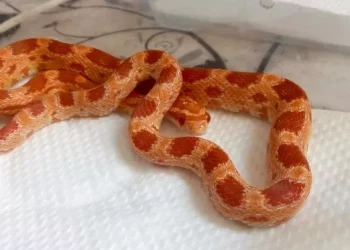When it comes to the world of reptiles, the names and classifications can be a bit confusing, especially for those new to the fascinating realm of snakes. One common question that arises is, “Is a corn snake a rat snake?” This question invites a deeper exploration of these two captivating species, their characteristics, habitats, and what makes them unique. In this article, we will delve into the similarities and differences between corn snakes and rat snakes, unraveling the mystery behind their names and shedding light on why both deserve our admiration.
Understanding the Basics: What Are Corn Snakes and Rat Snakes?
To tackle the question, let’s first define what we mean by corn snakes and rat snakes.
Corn Snakes
Corn snakes (Pantherophis guttatus) are a popular choice among pet owners and reptile enthusiasts. Known for their striking appearance and docile nature, they are a member of the rat snake family (Colubridae). Native to North America, corn snakes are often found in the southeastern United States, where they inhabit a range of environments from forests to grasslands. They typically grow to be between 2 and 6 feet long, with some individuals reaching lengths of up to 7 feet.
Corn snakes are particularly notable for their vibrant coloration. They come in various hues, including orange, yellow, and gray, often adorned with beautiful patterns of black or brown splotches that resemble the kernels of corn, hence their name. This striking appearance, combined with their friendly demeanor, makes them one of the most popular pet snakes in the world.
Rat Snakes
On the other hand, rat snakes refer to a broader group of snakes within the same family, Colubridae. The term “rat snake” generally encompasses several species, including the eastern rat snake (Pantherophis alleghaniensis), black rat snake (Pantherophis obsoletus), and many others. These snakes are also found across North America and are recognized for their ability to adapt to various habitats, from forests to fields.
Rat snakes typically exhibit a range of colors and patterns, but they are often less vibrantly colored than corn snakes. For instance, the black rat snake is predominantly black with a white underbelly, while the eastern rat snake features a striking pattern of gray and black. Rat snakes, like corn snakes, are non-venomous and are generally known for their gentle temperament, making them suitable for captivity.
The Classification Conundrum
Family Ties: Colubridae
Both corn snakes and rat snakes belong to the family Colubridae, which is the largest family of snakes, containing over 200 genera and nearly 1,000 species. This family is characterized by its non-venomous members, many of which are excellent climbers and are primarily found in terrestrial and arboreal habitats.
Genus Differentiation
While corn snakes are indeed part of the rat snake family, they fall under the genus Pantherophis, whereas other rat snakes can belong to different genera, such as Elaphe. This is where the confusion often arises. Corn snakes are specifically Pantherophis guttatus, while a common rat snake like the eastern rat snake is classified as Pantherophis alleghaniensis. The naming conventions can make it seem as though corn snakes are separate from rat snakes, but in reality, they are a specific species within the larger rat snake category.
Morphological Differences
When considering whether corn snakes are rat snakes, it’s important to examine their physical attributes. Corn snakes and other rat snakes share several similarities, such as elongated bodies and similar head shapes, but they can be differentiated based on coloration, size, and patterns. Corn snakes generally have a more vibrant palette, while rat snakes may feature more subdued hues. This distinction is crucial for herpetologists and reptile enthusiasts who seek to identify specific species in the wild or in captivity.
Habitats and Distribution
Corn Snake Habitats
Corn snakes thrive in various environments, including forests, fields, and even urban areas. They prefer habitats with ample cover, such as underbrush, leaf litter, and fallen logs. This preference for cover allows them to hide from predators and ambush their prey. Corn snakes are also excellent climbers, often seen basking in trees or hunting birds and their eggs.
Rat Snake Habitats
Rat snakes, similarly, are highly adaptable. They can be found in diverse habitats, from deciduous forests to agricultural fields. Their ability to thrive in human-altered landscapes makes them a common sight in rural areas. Rat snakes often seek refuge in barns, attics, and other structures, which can sometimes lead to conflicts with humans. However, their primary role in the ecosystem as rodent control agents is invaluable.
Diet and Feeding Habits
Corn Snake Diet
Corn snakes primarily feed on small mammals, birds, and occasionally reptiles. Their diet typically consists of rodents, including mice and young rats. Corn snakes are constrictors, meaning they subdue their prey by wrapping around it and squeezing until it suffocates. This method of hunting is effective and allows them to consume prey that may be larger than their heads, thanks to their flexible jaws.
Rat Snake Diet
Rat snakes share a similar diet, primarily feeding on rodents and birds. Their hunting techniques may vary slightly; some species of rat snakes are more adept climbers, allowing them to hunt birds directly in trees. Others may rely on ambushing techniques in tall grasses or underbrush. This versatility in hunting strategies showcases their adaptability and resourcefulness as predators.
Temperament and Behavior
Corn Snake Behavior
Corn snakes are known for their docile nature, making them excellent pets for beginners and experienced herpetologists alike. They are typically calm and can be handled with relative ease. Their inquisitive nature often leads them to explore their surroundings, and they may become accustomed to human interaction over time. Corn snakes are also known for their ability to recognize their owners and can display unique personalities, adding to their charm as pets.
Rat Snake Behavior
Rat snakes exhibit similar temperamental traits. They are generally non-aggressive and tend to avoid confrontation. However, they can be more defensive than corn snakes, especially if they feel threatened. In captivity, rat snakes can also become accustomed to handling and may display a calm demeanor. Their adaptability to different environments allows them to thrive in a variety of situations, whether in the wild or as pets.
Breeding and Reproduction
Corn Snake Reproduction
Corn snakes are oviparous, meaning they lay eggs. Breeding typically occurs in the spring, and females will lay a clutch of eggs ranging from 10 to 30. The eggs are usually deposited in a warm, moist location, such as rotting logs or leaf litter. The incubation period lasts around 60 to 65 days, after which the hatchlings emerge, fully independent and ready to hunt.
Rat Snake Reproduction
Rat snakes share a similar reproductive strategy. They also lay eggs and typically produce clutches of a comparable size. The breeding process is largely similar to that of corn snakes, with females finding suitable nesting sites for their eggs. The hatchlings are also independent from birth, showcasing the survival strategies of these adaptable reptiles.
Conservation Status
Corn Snake Conservation
Corn snakes are currently classified as a species of “Least Concern” by the International Union for Conservation of Nature (IUCN). However, they face threats from habitat loss and the illegal pet trade. Conservation efforts focus on protecting their natural habitats and raising awareness about their importance in ecosystems as rodent control agents.
Rat Snake Conservation
Rat snakes, too, are generally considered to be of “Least Concern.” However, like corn snakes, they are susceptible to habitat destruction and persecution due to misunderstandings about their role in the ecosystem. Public education and conservation initiatives are vital for ensuring these snakes continue to thrive in their natural environments.
The Role of Corn and Rat Snakes in Ecosystems
Both corn snakes and rat snakes play crucial roles in maintaining the balance of their ecosystems. As natural predators of rodents and birds, they help control populations of these species, which can otherwise become overabundant. This natural pest control contributes to healthier ecosystems, benefiting agricultural practices and promoting biodiversity.
Conclusion
So, are corn snakes rat snakes? The answer is both yes and no. Corn snakes are indeed a type of rat snake, falling within the same family, Colubridae, but they represent a distinct species known for their unique characteristics and behaviors. Both corn snakes and rat snakes are deserving of admiration for their roles in nature, their adaptability, and their contributions to human understanding of reptilian life.
In an age where many species face threats from habitat loss and environmental changes, it is essential to appreciate and protect these remarkable snakes. Whether as pets or as wild inhabitants of our ecosystems, corn snakes and rat snakes offer a glimpse into the beauty and complexity of the natural world. Understanding and respecting their place within it not only enriches our lives but also ensures that future generations can continue to marvel at these extraordinary creatures.
By celebrating the diversity within the world of snakes, we can foster a greater appreciation for all reptiles, promoting a more harmonious coexistence between humans and the natural world. So the next time someone asks if a corn snake is a rat snake, share this newfound knowledge and help demystify the captivating realm of these incredible reptiles.
Related Topics:


























